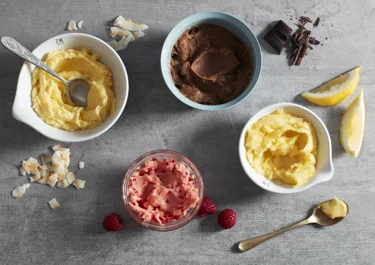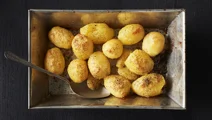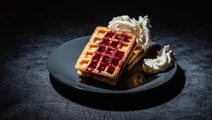Buttercream frosting

Making homemade buttercream frosting is fast, and easy, and requires just three staple ingredients: butter, icing sugar, and vanilla sugar. A traditional buttercream frosting with vanilla is perfect for decorating cakes and cupcakes, but a recipe for buttercream frosting like ours also leaves plenty of room to experiment with a wealth of different, fantastic flavours.
Ingredients
|
150 g
Soft butter
|
|
|---|---|
|
150 g
Icing sugar
|
|
|
2 tbsp
Vanilla sugar
|
Instructions
Tip
Perfect buttercream frosting has a creamy and velvety consistency. To ensure a smooth textured result each time, make sure to let the butter soften before combining it with the rest of the ingredients. Cutting the butter into smaller cubes will speed up this softening process. It should take cut-up butter about 20-25 minutes to soften at room temperature. As a rule of thumb, it is better to wait a little longer than attempt to combine butter that is too cold with icing sugar as the result may be grainy or gritty. Sifting the icing sugar while you wait for the butter to soften also helps prevent any potential graininess and ensures a thick, smooth frosting.
Tip
If the buttercream frosting becomes gritty, you have three options. 1) You can keep mixing it if you think the reason for the graininess is that the frosting has simply not been mixed enough yet, 2) if you have the time, you can let it rest and remix it after a few hours when the sugar has had time to 'melt' properly into the mixture, and 3) if you are in a hurry and need to fix it right away, you can add a pinch of liquid like cream or milk and keep mixing. Adding too much liquid may make the frosting separate or become runny so make sure to add only a little at a time till you have reached the perfect consistency for frosting or piping.
Questions about buttercream frosting
With a recipe for buttercream frosting like ours, making tasty, quick frosting is simple. Get started by reading our answers to some of the most frequently asked questions about this beloved frosting, including how to ensure the perfect taste and texture and how to store it.
What is buttercream frosting?
This frosting is made by combining soft butter, icing sugar, and flavouring like vanilla sugar. Since the frosting is used to fill, coat, and decorate baked goods like cakes and cupcakes, classic flavours for this type of frosting include vanilla, chocolate, strawberry, and lemon. But essentially, you can add any kind of flavouring. Using food colouring, the frosting may also be coloured in different shades for decoration purposes.
How to make buttercream frosting?
Buttercream frosting is the perfect way to fill, coat, or decorate baked goods and add a bit of luxurious richness. To make a wonderful, homemade frosting, simply beat soft butter until it has gained a fluffy texture and combine it with icing sugar and vanilla sugar a little at a time as you continue beating the mixture. Use your sweet and tasty frosting to decorate cakes or cupcakes. If you happen to eat a little, we will not judge you – we know just how delicious it is!
Can you freeze buttercream frosting?
Freezing homemade frosting is a good idea if you want to prepare it well in advance or in case you accidentally made a bit too much. In the freezer, the frosting will last for up to 3 months. Simply store it in an airtight container and remember to allow time for it to thaw to make it spreadable once more. Make sure you let it sit for at least 15 minutes on your countertop to ensure a creamy consistency. Alternatively, let the frosting thaw overnight in the refrigerator.
Does buttercream frosting need to be refrigerated?
You may be wondering how to store buttercream frosting and for how long it can sit out. Vanilla buttercream frosting does not need to be refrigerated. At room temperature (in a cool and dry area), this type of frosting will keep for up to 3 days, while it will last for up to 1-2 weeks in the refrigerator. Regardless of where you choose to store it, always store your homemade frosting in an airtight container to prevent it from spoiling or hardening. Because frosting made using butter keeps well, you can easily make it ahead of time.
How to thicken buttercream frosting?
Buttercream frosting is naturally softer and looser when it is warm, so before you decide to thicken your frosting to fix its consistency, chill it for a while in the refrigerator to see if this makes a difference. If not, to thicken the homemade frosting, simply add more icing sugar. Add the sugar a little at a time until the desired consistency has been reached to avoid making the frosting too stiff instead. If you accidentally added a bit too much icing sugar to thicken it, adding a bit of liquid like milk or cream is the answer to how to soften buttercream frosting again.
What is the difference between buttercream frosting and regular frosting?
While frosting is always whipped, usually sweet, and made using some kind of fat, it may be made using different ones. The four kinds of typical frosting are whipped cream frosting, meringue frosting, cream cheese frosting, and of course fluffy buttercream frosting. The major differences are found in the frostings' ingredient lists which give them different tastes and textures. Whipped cream frosting and meringue frosting both have very light and airy textures and are generally more delicate. As such, these frosting types cannot be used between cake layers. Cream cheese frosting, on the other hand, is more similar in texture to a thick buttercream frosting but has a different flavour profile. This frosting type has a fresher and tangier taste owing to both the cream cheese and the lemon juice it usually contains.
Can you use salted butter for buttercream frosting?
Basic buttercream frosting can be made using either salted or unsalted butter. Using salted butter may make your homemade frosting a little less sweet but it will not make it taste outright salty. The most important thing to remember concerning the butter is to choose a butter with a high fat content to ensure the frosting's structure (do not substitute it with margarine) and to let it soften completely before combining it with icing sugar. If the butter is too cold, it will be difficult to combine it properly with the sugar which may result in a grainier texture.
Classic vanilla buttercream frosting
The best buttercream frosting has a sweet and rich flavour that complements the flavour profiles of many different cakes and cupcakes well. The whipped frosting has a creamy, velvety texture that makes it perfect for piping. Our vanilla-flavoured frosting is no different. It is thick and fluffy without being dense and with its subtle floral undertones and complex, rich sweetness, you will want to make it again and again.
If reading about this delicious vanilla-flavoured frosting has made you curious about homemade frosting in general, we suggest having a look at our recipe for cream cheese frosting as well. Both varieties of frosting are delicious, and they are different enough that knowing how to make both gives you a wealth of opportunities to frost and decorate all kinds of cake.
Pipe on cakes and cupcakes
Besides providing delicious flavours, homemade frosting can be used in different ways when making a cake. For instance, you can use the frosting for piping decorative swirls or rosettes onto your baked goods. Because of its thick consistency, this type of frosting may also be used between the layers of tiered cakes to add flavour, provide moisture, and secure the cake's stability. Lastly, our easy buttercream frosting has another very practical use: it can make homemade cakes ready to be covered in marshmallow fondant. Frosting a cake with buttercream like this before covering it with fondant helps ensure a smooth surface to which the fondant may adhere. This allows you to serve a cake with a beautiful finish that is sure to delight and impress your guests.
Use different flavours
While a simple buttercream frosting tastes great, experimenting with adding different flavours is a very fun way to be creative in the kitchen. Essentially, you can flavour your homemade frosting using almost any flavour like coffee, peanut, coconut, raspberry, cherry, caramel, chai, or pumpkin spice. Below, we delve into three of the most popular variants.
Chocolate buttercream frosting
Among delicious frosting recipes, a chocolate buttercream frosting may be the most popular of all. Use cocoa powder or cooled, melted dark chocolate to create a rich and indulgent frosting perfect for sweet baked goods like our banana muffins or cakes with orange or coffee flavours. Using melted chocolate rather than cocoa powder gives you the option of choosing your favourite kind of chocolate, meaning you can create a delicate milk chocolate or a sweet white chocolate buttercream frosting as well.
Strawberry buttercream frosting
Whipping up a homemade strawberry buttercream frosting is also a very popular option. Use ground freeze-dried strawberries or a purée made from either fresh or frozen strawberries to create a frosting with a mild strawberry taste. Use about 25 g of purée to make it too ‘wet’ and not compromise on the texture. If it gets too soft, add a bit more icing sugar. This subtle berry flavour will deepen if you prepare the frosting a day in advance. The bright pink colouring of this strawberry frosting looks amazing on a dark chocolate cake like ours but is also very suited to vanilla cupcakes and the like.
Lemon buttercream frosting
You cannot go wrong with a fresh lemon buttercream frosting either. Freshly squeezed lemon juice and a bit of lemon zest brighten the rich and fluffy frosting by introducing a tanginess that complements the icing sugar’s sweetness beautifully. Light-yellow lemon frosting functions great as a surprising filling in sweet layer cakes as well as a frosting for more spicy cakes like moist carrot cake or festive gingerbread cupcakes.








